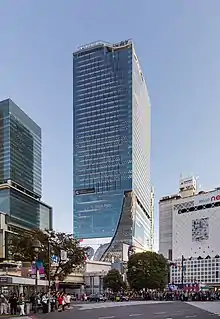Shibuya
Shibuya (渋谷区, Shibuya-ku, [ɕibɯ̟ᵝja̠] ⓘ) is a special ward in Tokyo, Japan. A major commercial and finance center, Shibuya houses two of the busiest railway stations in the world, Shinjuku Station (southern half) and Shibuya Station.
Shibuya
渋谷区 | |
|---|---|
| Shibuya City | |
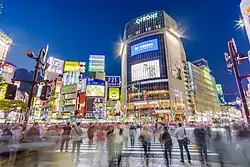 | |
 Flag  Seal | |
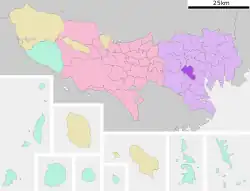 Location of Shibuya in Tokyo | |
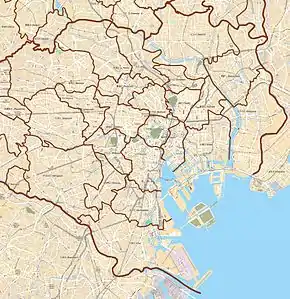 Shibuya 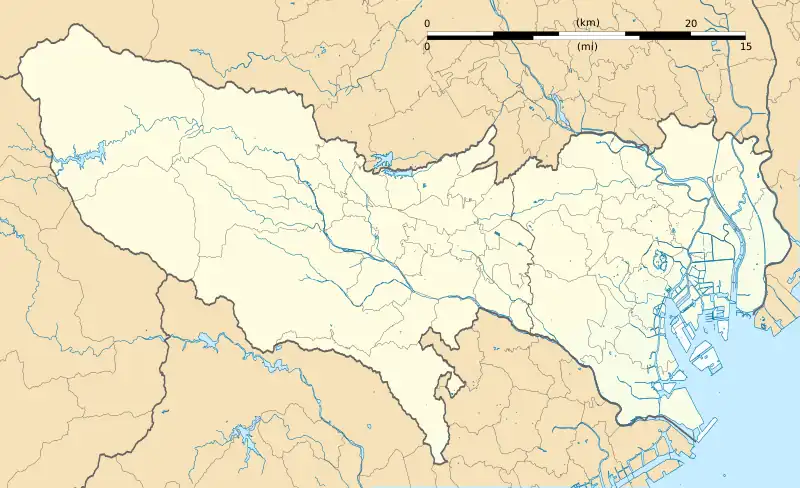 Shibuya Shibuya (Tokyo) 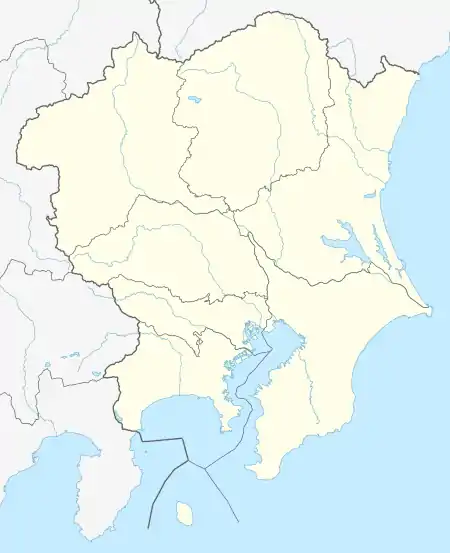 Shibuya Shibuya (Kanto Area)  Shibuya Shibuya (Japan) | |
| Coordinates: 35°39′34″N 139°42′02″E | |
| Country | Japan |
| Region | Kantō |
| Prefecture | Tokyo |
| Government | |
| • Mayor | Ken Hasebe (since April 2015) |
| Area | |
| • Total | 15.11 km2 (5.83 sq mi) |
| Population (October 1, 2020[1]) | |
| • Total | 243,883 |
| • Density | 16,140/km2 (41,800/sq mi) |
| Time zone | UTC+9 (Japan Standard Time) |
| Symbols | |
| • Tree | Zelkova serrata |
| • Flower | Iris ensata |
| City office | Shibuya 1-18-21, Shibuya-ku, Tokyo 150-8010 |
| Website | www |
As of April 1, 2022, Shibuya Ward has an estimated population of 228,906 and a population density of 15,149.30 people per km2 (39,263.4/sq mi). The total area is 15.11 km2 (5.83 sq mi).
Notable neighborhoods and districts of Shibuya include Harajuku, Ebisu, Omotesandō, Yoyogi and Sendagaya. "Shibuya" is also commonly used to refer to the area surrounding Shibuya Station, an area known as a major center for Japanese fashion and youth culture and one of Tokyo's most popular nightlife areas.
History
Heian to Edo period
Shibuya was historically the site of a castle in which the Shibuya family resided from the 11th century through the Edo period. Following the opening of the Yamanote Line in 1885, Shibuya began to emerge as a railway terminal for southwestern Tokyo and eventually as a major commercial and entertainment center.
Meiji to Showa period
The village of Shibuya was incorporated in 1889 by the merger of the villages of Kami-Shibuya, Naka-Shibuya and Shimo-Shibuya within Minami-Toshima County (Toyotama County from 1896). The village covered the territory of modern-day Shibuya Station area as well as the Hiroo, Daikanyama, Aoyama, and Ebisu areas. Shibuya became a town in 1909. The town of Shibuya merged with the neighboring towns of Sendagaya (which included the modern Sendagaya, Harajuku and Jingumae areas) and Yoyohata (which included the modern Yoyogi and Hatagaya areas) to form Shibuya-ku suburban ward upon being absorbed into Tokyo City in 1932. Shibuya became an urban special ward under the Local Autonomy Act in 1947.
The Tokyu Toyoko Line opened in 1932, making Shibuya a key terminal between Tokyo and Yokohama, and was joined by the forerunner of the Keio Inokashira Line in 1933 and the forerunner of the Tokyo Metro Ginza Line in 1938. One of the best-known stories concerning Shibuya is the story of Hachikō, a dog who waited on his late master at Shibuya Station every day from 1923 to 1935, eventually becoming a national celebrity for his loyalty. A statue of Hachikō was built adjacent to the station, and the surrounding Hachikō Square is now the most popular meeting point in the area.
Post-War Showa
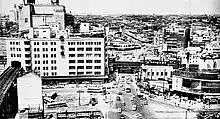
During the occupation of Japan, Yoyogi Park was used as a housing compound for U.S. personnel known as "Washington Heights." The U.S. military left in 1964, and much of the park was repurposed as venues for the 1964 Summer Olympics. The ward itself served as part of the athletics 50 km walk and marathon course during the 1964 games.[2]
Shibuya has achieved great popularity among young people since the late 70s. There are several famous fashion department stores in Shibuya. Shibuya 109 is a major shopping center near Shibuya Station, particularly famous as the origin of the kogal subculture. Called "Ichi-Maru-kyū," which translates as 1–0–9 in Japanese, the name is actually a pun on that of the corporation that owns it — Tōkyū (which sounds like 10–9 in Japanese; this is numerical substitution, a form of goroawase wordplay). The contemporary fashion scene in Shibuya extends northward from Shibuya Station to Harajuku, where youth culture reigns; Omotesandō, the zelkova tree- and fashion brand-lined street; and Sendagaya, Tokyo's apparel design district.
Heisei period
In 1985, Teamer created a new culture in Shibuya. During the mid 90s, Shibuya also became known as the center of the IT industry in Japan. It was often called "Bit Valley" in English, a pun on both "Bitter Valley", the literal translation of "Shibuya", as well as bit, the computer term for binary digits.
Shibuya Stream, a skyscraper and retail complex, was completed in 2018.
Reiwa period
The East Wing of a mixed-used skyscraper Shibuya Scramble Square was completed in August 2019. Shibuya's new gateway Shibuya Fukuras was completed in October 2019.
2019 New Year's Day vehicle attack
During the early morning of January 1, 2019, a 21-year-old man named Kazuhiro Kusakabe drove his minicar into a crowd of pedestrians celebrating New Year's Day on Takeshita Street. The man claimed his actions were a terrorist attack, and later stated that his intention was to retaliate against the usage of the death penalty for Aum Shinrikyo doomsday cult members. The man attempted to flee but was soon apprehended by authorities in a nearby park.[3][4]
Miyashita Park has reopened in July 2020 as a shopping complex with a rooftop park.
Geography
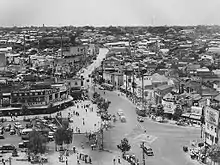
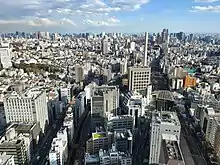
Shibuya includes many well-known commercial and residential districts such as Daikanyama, Ebisu, Harajuku, Hiroo, Higashi, Omotesandō, Sendagaya, and Yoyogi.
Districts
- Hatagaya Area:
- Yoyogi Area:
- Sendagaya Area:
- Ebisu-Ōmukai Area:
- Hikawa-Shimbashi Area:
Politics and government
Shibuya is run by a city assembly of 34 elected members. The mayor is Ken Hasebe, an independent.
Elections
Same-sex partnership certificate
In 2015, as the council passed "Ordinance for Promoting Respect of Gender Equality and Diversity in the Ward",[5] Shibuya Ward became the first Japanese municipality that issues same-sex partnership certificates.[6] According to this ordinance, same-sex couples who live in Shibuya are allowed "to rent apartments together, and have gained hospital visitation rights as family members".[6] The ordinance was intended to bring three benefits to same-sex couples: "(1) rental housing within the ward (co-signing of tenancy agreements for municipal/public housing), (2) medical institutions within the ward (hospital visitation and medical decision-making rights as family members), and (3) employment conditions within the ward (e.g. family benefits, congratulations and condolence leave)".[5] In order to apply for the certificate, couples must be 20-years-old or older residents of Shibuya Ward and have to state that "their relationship is based on love and mutual trust" in a notarized document.[7] Koyuki Higashi (a former member of the Takarazuka Revue) and Hiroko Masuhara (an entrepreneur), a lesbian couple, were the first to receive this certification.[7] Since the Shibuya Ward passed the ordinance, seven other municipalities in Japan have begun offering similar certificates.[8]
The BBC notes that in practice, the ordinance is not binding, though their names will be posted on the ward's website if they violate the ordinance.[9] Shimizu says the system "is not equivalent to marriage, as it does not accord same-sex couples the same rights as heterosexual couples when it comes to inheritance, joint filing of taxes, or social welfare".[5] As it requires at least a hundred thousand yen to apply for the certificate, it can be restrictive to some couples.[10] Shimizu argues that Shibuya Ward has been criticized for pinkwashing as "while passing this ordinance, the administration also moved to expel the homeless in Miyashita Park and other parks in the ward".[5] Pointing out that the mayor of Shibuya Ward in an interview stated that this is not a matter of human rights, but of diversity, Yuri Horie claimed that the term of diversity seems to be used to divide citizens into the good and the bad; it raises only the ones who contribute to the consumeristic society as representer of "diversity of sexuality" while excluding the useless ones.[11] Yuki Tsuchiya, a lesbian activist, also argues that LGBT individuals are used to promote the ward.[12]
Sightseeing and historic sites
.jpg.webp)
Shibuya is famous for its scramble crossing, called Shibuya Crossing.[13] It is located in front of the Shibuya Station Hachikō exit and stops vehicles in all directions to allow pedestrians to inundate the entire intersection. Shibuya Crossing is the "world's busiest pedestrian crossing", with upwards of 3,000 people at a time.[14][15][16] The statue of Hachikō, a dog, between the station and the intersection, is a common meeting place and almost always crowded.
On the southwest side of Shibuya station, there is another popular meeting place with a statue called "Moyai". The statue resembles a Moai statue, and it was given to Shibuya by the people of Niijima Island in 1980.
Green areas
- Meiji Shrine, Shinto shrine dedicated to the souls of Emperor Meiji and Empress Shōken, surrounded by a 700,000-square-meter forest.
- Shinjuku Gyo-en (Sendagaya), former Imperial gardens now open to the public as a park.
- Yoyogi Park, once a training base for the Imperial Japanese Army, later the Washington Heights housing area for the Occupation of Japan, then the lodgings for contestants in the Tokyo Olympics.
Buildings
_01_(15554736517).jpg.webp)
- Shibuya 109, a popular and trendy place for mostly Japanese young women to shop.
- United Nations University
- Bunkamura, cultural center and concert hall complex
- Cerulean Tower, formerly the tallest building in the Shibuya Station area
- Yebisu Garden Place (Ebisu), site of the former Sapporo Brewery, now featuring restaurants and shopping, along with the Westin Hotel
- National Noh Theatre (Sendagaya)
- New National Theatre (Hatsudai), site of opera, ballet, and other performances
- NHK Broadcasting Center, headquarters of the NHK radio, television, and satellite broadcasting system
- NTT Docomo Yoyogi Building, the fourth-tallest building in Tokyo, patterned after the Empire State Building
- Omotesandō Hills, a shopping mall completed in 2006
- Shibuya Fukuras
- Shibuya Hikarie
- Shibuya Scramble Square
- Shinjuku Southern Terrace (Sendagaya)
- Takashimaya Times Square (Sendagaya), one of the largest department stores in Japan
- Tokyo Metropolitan Gymnasium (Sendagaya), a major indoor arena complex
- Tokyo Baptist Church
- Tokyo Camii, the largest mosque in Japan
- Yoyogi National Gymnasium, designed for the 1964 Olympics by Kenzo Tange.
- Shibuya Sky, 360-degree observatory at the highest point in the district of Shibuya overlooking Shibuya and the greater Tokyo skyline
Streets and places
- Aoyama Dōri, a major east–west thoroughfare
- Center Gai
- Dōgen-zaka, a road in central Shibuya famous for its surrounding nightclubs and love hotels
- Komazawa Dōri – running past Daikanyama, down the hill to Ebisu, crossing Meiji Dōri and up the hill through Higashi and Hiroo. The road stops at the Shuto Expressway in Minami Aoyama. Famed for its beautiful trees that turn bright yellow in autumn, cafes, restaurants, and a large replica of Michelangelo's David outside of the Papas building. Prince Hitachi and Princess Hitachi have their official residence in a palace in large gardens off Komazawadori in Higashi.[17]
- Kōen Street, in central Shibuya between Shibuya Station and Yoyogi Park.
- Meiji Dōri, a major north–south thoroughfare parallel to the Yamanote Line.
- Miyamasu-zaka
- Nonbei-Yokocho, a small street near the rail tracks famous for its small bars and old Tokyo feel.
- Omotesandō, an avenue leading up to the Meiji Shrine with a number of famous-brand boutiques
- Spain-zaka
- Takeshita Street, a shopping street through Harajuku
- Yamanote Street
- Shibuya
- Ebisu
- Harajuku
- Hiroo
- Sendagaya
- Yoyogi
Transportation
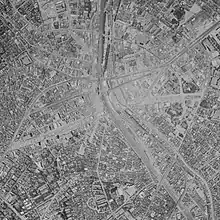
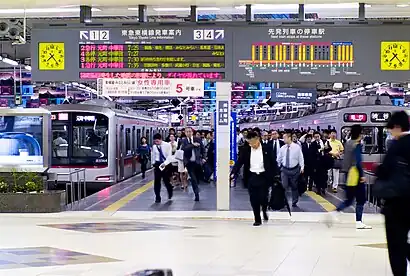

Rail
The main station in Shibuya is Shibuya Station. The southern half of Shinjuku Station, including the New South Entrance, is located in Shibuya.
- JR East
- Yamanote Line: Shinjuku, Yoyogi, Harajuku, Shibuya, Ebisu stations
- Chūō Line (Rapid), Chūō-Sōbu Line: Shinjuku, Yoyogi, Sendagaya stations
- Saikyō Line, Shōnan-Shinjuku Line: Shinjuku, Shibuya, Ebisu stations
- Tokyo Metro
- Ginza Line: Shibuya station
- Marunouchi Line: Shinjuku station
- Hibiya Line: Ebisu station
- Chiyoda Line: Meiji Jingūmae, Yoyogi Kōen, Yoyogi Uehara stations
- Hanzōmon Line: Shibuya station
- Fukutoshin Line: Shibuya, Meiji Jingūmae, Kitasandō stations
- Tokyo Metropolitan Bureau of Transportation
- Toei Shinjuku Line: Shinjuku station
- Toei Ōedo Line: Shinjuku, Yoyogi, Kokuritsu Kyogi-jo stations
- Tokyu Corporation
- Tōyōko Line: Shibuya, Daikanyama stations
- Den-en-toshi Line: Shibuya, Ikejiri Ohashi stations
- Keio Corporation
- Inokashira Line:Shinjuku, Shibuya, Shinsen stations
- Keiō Line: Shinjuku, Sasazuka stations
- Keiō New Line: Shinjuku, Hatsudai, Hatagaya, Sasazuka stations
- Odakyu Electric Railway Odawara Line: Shinjuku, Minami Shinjuku, Sangubashi, Yoyogi Hachiman, Yoyogi Uehara stations
- The Imperial Platform, used by the Japanese Imperial Family on rare occasions, is located along the Yamanote Line, a few minutes walk from Harajuku Station in Sendagaya 3-chome.
Highway
- Shuto Expressway
- No.3 Shibuya Route (Tanimachi JCT – Yoga)
- No.4 Shinjuku Route (Miyakezaka JCT – Takaido)
- National highways
Economy
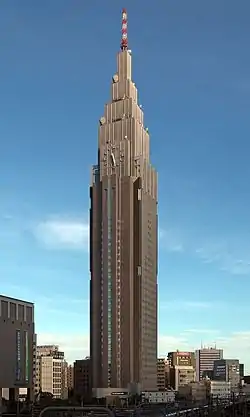
Several companies are headquartered in Shibuya.
Calpis,[18] Casio,[19] Mixi,[20] Niwango,[21] Nihon Dempa Kogyo,[22] and Tokyu Corporation have their headquarters in Shibuya.[23] East Japan Railway Company[24] have their headquarters in Yoyogi, Shibuya. 81 Produce has its headquarters in Tomigaya, Shibuya.[25][26]
Former operations
At one time Smilesoft had its headquarters in the CT Sasazuka Building in Shibuya.[27] In May 1985 the headquarters of Bandai Visual moved to Shibuya. In March 1990 the headquarters moved to Shinjuku.[28]
A.D. Vision - Tokyo, Y.K., the Japanese subsidiary of A.D. Vision, was in Shibuya.[29] Acclaim Entertainment once had its Tokyo office in the Nomora Building.[30] The Japanese subsidiary of Titus Interactive, Titus Japan K.K., had its head office on the eighth floor of the Kotubuki Dogenzaka Building in Dōgenzaka.[31] The former animation studio; Group TAC was also located here.
Square Enix had its headquarters in Yoyogi before moving to Shinjuku ward in 2012.[32]
Companies
- Amway Japan: Japan headquarters, a multi-level marketing company[33]
- Coca-Cola Japan[34]
- Campbells Soup's Japan division is headquartered in Shibuya, on the 10th floor of the Tokyo Tatemono Hiroo Building.[35]
- CyberAgent: Internet advertising agency[36]
- East Japan Railway Company (JR East)[37]
- Gap Japan[38]
- Ito En: bottler of tea, coffee, vegetable drinks, and other beverages[39]
- NHK (Nippon Hoso Kyokai) (NHK Broadcasting Center)[40]
- Papas: clothing, cafe, and bakery company[41]
- Sapporo Breweries Limited[42]
- Trend Micro Japan: security software company[43]
Education
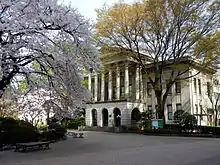
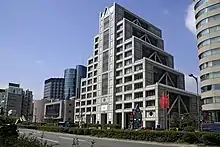
Colleges and universities
Primary and secondary schools
The Shibuya City Board of Education operates public elementary and junior high schools, while Tokyo Metropolitan Government Board of Education operates public senior high schools.
- Aoyama Gakuin Elementary, Junior and Senior High School—private co-ed school, in Shibuya, affiliated with Aoyama Gakuin University
- Aoyama High School—public co-ed school, in Jingūmae
- The British School in Tokyo Shibuya Campus
- First Commercial High School—public co-ed school, in Daikanyama
- Fujimigaoka Junior and Senior High School—private girls' school, in Sasazuka
- Hiroo Gakuen Junior and Senior High School—private co-ed school, in Hiroo
- Hiroo High School—public co-ed school, in Higashi
- International School of Sacred Heart, in Hiroo
- Jingūmae International Exchange School (JIES), within the Shibuya Ward Jingūmae Elementary School in Omotesando
- Jissen Joshi-Gakuen Elementary, Junior and Senior High School—private girls' school, in Higashi, affiliated with Jissen Women's University
- Kantō Kokusai Senior High School—private co-ed school, in Honchō
- Kokugakuin Senior High School—private co-ed school, in Jingūmae
Public combined elementary and junior high schools[44][45]
- Shibuya Honmachi Gakuen (渋谷本町学園)
Junior high schools:[44]
- Hachiyama Junior High School (鉢山中学校)
- Harajuku Gaien Junior High School (原宿外苑中学校)
- Hiroo Junior High School (広尾中学校)
- Sasazuka Junior High School (笹塚中学校)
- Shoto Junior High School (松濤中学校)
- Uehara Junior High School (上原中学校)
- Yoyogi Junior High School (代々木中学校)
Elementary schools:[45]
- Hatashiro Elementary School (幡代小学校)
- Hatomori Elementary School (鳩森小学校)
- Hiroo Elementary School (広尾小学校)
- Jingumae Elementary School (神宮前小学校)
- Jinnan Elementary School (神南小学校)
- Kakezuka Elementary School (加計塚小学校)
- Nagayato Elementary School (長谷戸小学校)
- Nakahata Elementary School (中幡小学校)
- Nishihara Elementary School (西原小学校)
- Rinsen Elementary School (臨川小学校)
- Sarugaku Elementary School (猿楽小学校)
- Sasazuka Elementary School (笹塚小学校)
- Sendagaya Elementary School (千駄谷小学校)
- Tokiwamatsu Elementary School (常磐松小学校)
- Tomigaya Elementary School (富谷小学校)
- Uehara Elementary School (上原小学校)
- Yoyogisanya Elementary School (代々木山谷小学校)
Public libraries
Shibuya operates several public libraries, including the Central Library, the Nishihara Library, the Shibuya Library, the Tomigaya Library, the Sasazuka Library, the Honmachi Library, and the Rinsen Library. In addition, the Yoyogi Youth Hall houses the Yoyogi Library Room.[46]
In popular culture
Diplomatic missions
Several countries operate their embassies in Shibuya.[47]
Gallery
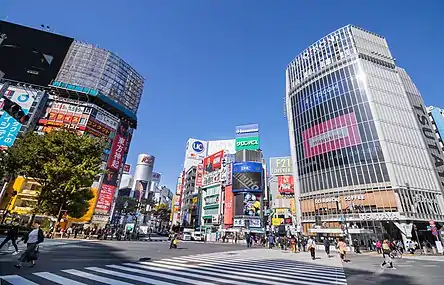 Shibuya crossing at ground level
Shibuya crossing at ground level.jpg.webp) View from the Sky View observation deck
View from the Sky View observation deck.jpg.webp) Shibuya crossing at night
Shibuya crossing at night.jpg.webp) Streets of Shibuya at night
Streets of Shibuya at night "The Iceberg", building in Shibuya
"The Iceberg", building in Shibuya
See also
- similar venues with electronic billboards, jumbotrons and media towers.
References
- "Population by District". Tokyo Statistical Yearbook. Retrieved July 15, 2022.
- 1964 Summer Olympics official report. Volume 2. Part 1. p. 74.
- "8 injured as man rams car into pedestrians in Harajuku in 'retaliation for execution'". Japan Today. January 1, 2019. Archived from the original on January 1, 2019.
- "Tokyo car attack: Driver hits New Year's revelers in city's Harajuku district". CNN. January 1, 2019.
- Shimizu, Yudai (2015). "Shibuya Wardʼs "Same-sex Partnership Ordinance"" (PDF). CGS Newsletter. 18: 5.
- .McCurry, Justin (November 5, 2015). "Same-sex couple receives Japan's first 'partnership' certificate". the Guardian. Retrieved April 16, 2018.
- Murai, Shusuke (November 5, 2015). "Tokyo's Shibuya and Setagaya wards issue first same-sex partnership papers". The Japan Times Online. ISSN 0447-5763. Retrieved April 18, 2018.
- Koide, Daiki (March 15, 2018). 宮崎)宮大の学生 同性パートナーシップ条例案提出:朝日新聞デジタル. 朝日新聞デジタル (in Japanese). Retrieved April 16, 2018.
- "Tokyo ward certifies 'gay marriage'". BBC News. March 31, 2015. Retrieved April 16, 2018.
- 渋谷区の同性婚条例に疑問の声 「費用10万円」申請しないカップルも. 東スポWeb - 東京スポーツ新聞社 (in Japanese). February 25, 2016. Retrieved April 16, 2018.
- Domon, Minoru (May 18, 2016). 「レズビアン」という生き方 キリスト教のなかで「性」や「愛」を考える 大阪聖パウロ教会で講演会(1). クリスチャントゥデイ (in Japanese). Retrieved April 16, 2018.
- 渋谷区「同性婚条例」にダメ出し 当事者から出てきた冷ややかな声. 東スポWeb - 東京スポーツ新聞社 (in Japanese). March 28, 2015. Retrieved April 19, 2018.
- Murray Buechner, Maryanne. "Tokyo: 10 Things To Do". Time: Travel. Archived from the original on May 25, 2009.
- 井上恵一朗 (April 22, 2016). "【東京はてな】 渋谷交差点、1回で3千人横断?". 朝日新聞. p. 29.
- "渋谷スクランブル交差点――世界で最もワイルドな交差点にようこそ". CNN.co.jp. August 25, 2019. Archived from the original on September 23, 2020. Retrieved September 26, 2019.
- "The World's Busiest Pedestrian Crossing". WorldAtlas. March 5, 2018. Archived from the original on August 12, 2020. Retrieved April 13, 2020.
- Kunaicho |The Imperial Palace and other Imperial Household Establishments
- "Company Outline Archived 2010-02-05 at the Wayback Machine." Calpis. Retrieved on February 12, 2010.
- "Corporate." Casio. Retrieved on February 25, 2009
- "Company Overview Archived September 14, 2017, at the Wayback Machine." Mixi. Retrieved on April 3, 2012. "Headquarter address Sumitomo Fudosan Shibuya First Tower 7F, 1-2-20 Higashi, Shibuya-ku, Tokyo, 150-0011, Japan"
- "会社情報." Niwango. Retrieved on February 26, 2011. "〒150-0001 東京都渋谷区神宮前1-15-2 ニコニコ本社ビル."
- "Profile." Nihon Dempa Kogyo. Retrieved on May 16, 2019.
- "会社概要 Archived 2009-11-22 at the Wayback Machine." Tokyu Corporation. Retrieved on November 27, 2009.
- East Japan Railway Company. "JR East Corporate Data". Retrieved June 20, 2009.(in English)
- 株式会社81プロデュース 会社概要. 81 Produce. Retrieved April 5, 2010.
- 株式会社81プロデュース アクセスマップ. 81 Produce. Retrieved April 5, 2010.
- "会社概要." Smilesoft. February 12, 2002. Retrieved on February 11, 2010.
- "History Archived February 17, 2007, at the Wayback Machine." Bandai Visual. Retrieved on March 16, 2010.
- "Contact ADV Archived 2009-08-02 at the Wayback Machine." A.D. Vision. Retrieved on May 8, 2009.
- "Worldwide locations." Acclaim Entertainment. June 23, 2000. Retrieved on July 8, 2010.
- "Contact." Titus Interactive. 3 June 2004. Retrieved on 4 September 2012.
- "会社概要". Square Enix. Retrieved October 17, 2020.
- "日本アムウェイ(Amway)の会社概要|日本アムウェイ(Amway)公式企業サイト". Amway. Retrieved October 17, 2020.
- "Company Profile". Retrieved October 17, 2020.
- "Profile." Campbells Soup Japan. Retrieved on November 10, 2008.
- "Overview". CyberAgent. Retrieved October 17, 2020.
- "Corporate Data". East Japan Railway Company. Retrieved October 17, 2020.
- "Company Profile". GAP. Retrieved October 17, 2020.
- "Global Expansion and Business Locations". Ito En. Retrieved October 17, 2020.
- "Summary". NHK. Retrieved October 17, 2020.
- "About". Papas. Retrieved October 17, 2020.
- "Office". Sapporo Breweries. Retrieved October 17, 2020.
- "Contact Locations Worldwide". Trend Micro. Retrieved October 17, 2020.
- "学校別通学区域(中学校)". Shibuya. Retrieved November 6, 2022.
- "学校別通学区域(小学校)". Shibuya. Retrieved November 6, 2022.
- "Shibuya City Office/Library". City.shibuya.tokyo.jp. Retrieved February 7, 2014.
- "Shibuya City Office/Embassies".
External links
- Shibuya City Official Website (in Japanese)

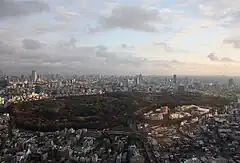

.jpg.webp)
